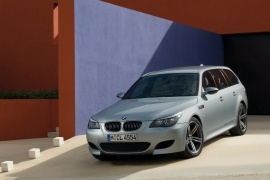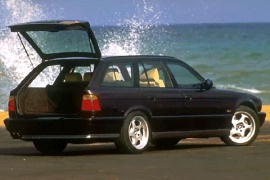BMW M5 Touring Models/Series Timeline, Specifications & Photos
First production year: 1992
Engines: Gasoline
Body style: Wagon (station wagon, estate, combi, touring)
BMW refreshed the fifth generation of the 5 Series in 2007 and, along with it, unveiled the M-powered version of the 5 Series Touring.
The introduction of an M-powered version for the 5 Series station wagon was no longer something unexpected since the previous M5 (the E34) was also available with a long-roof shape. But creating one offered exclusively with the SMG single-clutch automated gearbox was. However, BMW had to do something to improve the sales of the fifth generation of the 5 Series, which were not particularly high. Furthermore, the station wagon didn’t do well on the market compared with the carmaker’s main rivals, Mercedes-Benz and Audi. As a result, the 2007 M5 Touring broke covers and stirred emotions. While it wasn’t sold in high numbers, it became one of the fastest family vehicles on the market.
BMW already knew the recipe for how to make a station wagon go fast. Moreover, since it produced the vehicle on the assembly line, it mixed the bodywork of the 5 Series Touring with parts carried over from BMW Motorsport. As a result, the M5 Touring sported the front fascia of the M5 Sedan. It featured a lower apron fitted with a broad center air intake flanked by leaf-shaped functional side scoops. In addition, the automaker installed the headlights used on the LCI version of the 5 Series, with their clear lenses over the twin headlamps and clear turn signal lamps fitted with orange bulbs.
From its profile, the M5-specific front fenders were adorned by horizontal vents placed above the clear turn signal lamps. As an option, the door mirrors could be fitted with carbon fiber trims on their lower parts. The five double-spoke 19-inch light-alloy wheels and the pulled-out side sills were specific for the M5 lineup. Unlike its sedan sibling, the M5 Touring featured a longer roof, extended above the rear seats and the trunk space. Finally, at the back, the redesigned rear bumper was unique for the M5 Touring, featuring a deep cut to allow a lower loading height and a diffuser under it that integrated a pair of twin exhausts.
Inside, BMW installed a new iDrive infotainment system, which included new features and updates. Atop the center stack, the automaker placed a color display for it, with a sharper image than its predecessor. At the same time, fronting the driver was the instrument cluster, with a tachometer marked up to 9,000 rpm and the speedometer to 330 kph (205 mph). On the center console, BMW placed the short gear selector of the six-speed automated gearbox. In the back, there was plenty of room for three adults on the split-folding bench seat. Customers could lower the seatbacks from there and enlarge the trunk space from 500 liters (17.7 cu-ft) to a respectable 1,650 liters (58.3 cu-ft).
BMW installed the same S62B50 V8 gasoline engine as in the regular E60. Unlike its sedan sibling, this car was available exclusively fitted with a seven-speed automated gearbox. The 507 PS (500 hp) obtained from the V10 powerplant was sent to the rear wheels wearing wide rubbers on it.
BMW surprised its customers when it introduced the M5 version of the Touring in 1992, challenging its competitors to create similar go-fast station wagons.
The German automaker introduced the 5 Series (the E12) on the market in 1972 as a sedan and kept it that way up until the third generation, which it released in 1988. But then, in 1992, BMW refreshed the lineup, and besides the sedan, it also introduced the station wagon, which was named Touring, according to the carmaker’s naming system. If that was not enough, then the addition of a hand-built M5 Touring was even more surprising. But customers were not prepared for such a vehicle. As a result, the automaker managed to sell less than 1,000 units of it. The good side of the story was that all of them came with the enhanced S38B38 inline-six engine, which was more potent than its predecessor.
At the front, the E34 M5 Touring had a slightly different look than its non-M siblings. While it still had the same four-headlight design as the rest of the range, the black grille between them was adorned by a small M5 badge with the classic red/dark-blue/light-blue colors of the BMW Motorsport. In addition, the motorsports specialist installed a new apron with two rectangular foglamps and a gray lip spoiler underneath.
The M5 Touring shared its bodywork with the rest of the range. After it was painted, it was delivered to BMW M, in Garching near Munich, to be completed. There, it was hand-assembled to a large extent, resulting in superior finishing and alignment of the body panels. Up to the B-post, it was similar to its sedan sibling. Behind, up to the D-pillars, it was a different story. It featured an extended roof behind the rear passengers, up to the mid-section of the trunk space. A chromed twin exhaust peaked out underneath the M-specific rear bumper.
Inside, the M5 Touring boasted a leather-wrapped cabin and a few M details. The lower spoke of the steering wheel and the instrument panel were adorned by M badges. Furthermore, the tri-color motif of the car manufacturer was applied to the gear-knob and the upholstery. An LED display installed at the bottom of the instrument panel showed information from the car’s onboard computer, which could be accessed via a small button placed on the turn-signal stalk. Vehicles with electronically controlled dampers were fitted with a switch mounted on the instrument cluster’s visor edge. In the back, customers could sit on a split-folding (60/40) bench seat that could expand the trunk space from 420 liters (14.8 cu-ft) to 1,670 liters (59 cu-ft).
Under the hood, BMW installed the new S38B38 engine that produced 340 PS (335 hp) and paired it with a five-speed manual gearbox that sent all the oomph to the rear wheels. But that was not the only upgrade to the vehicle. BMW Motorsport also installed a stiffer suspension and a limited-slip differential. As a result, with all the upgrades, the 1992 M5 Touring could go from 0 to 100 kph (0-62 mph) in 5.9 seconds on its way to a capped top speed of 250 kph (155 mph).

